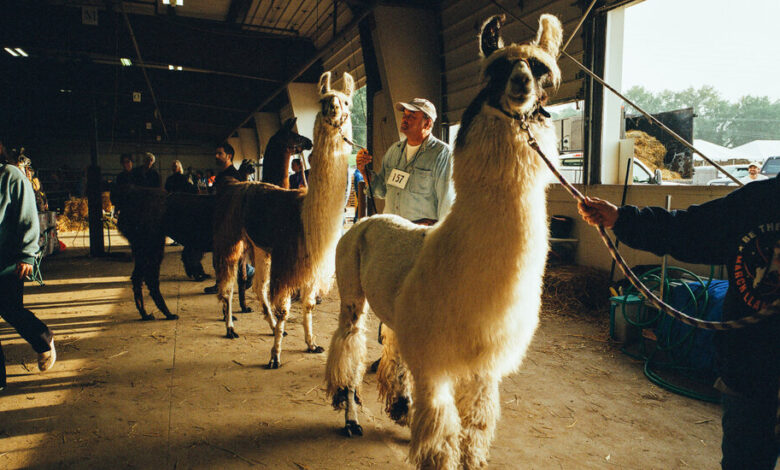Llamas Are Loved in New England, as Pets, Guards and More

To owners in the Northeast, the animals can put on quite a show — and do a lot more.
WHY WE’RE HERE
We’re exploring how America defines itself one place at a time. In Massachusetts, a beloved agricultural fair was the setting for a distinct subculture of animal lovers.
Reporting from West Springfield, Mass.
It took Diego Camacho nearly a year to construct a competition-worthy “Aladdin’s genie” costume for his llama, Eclipse. He had to sew a form-fitting gold garment for the animal’s body, face and tail — plus matching gold stockings — and construct a three-foot-tall genie to ride on the llama’s back.
“I wanted something that would have that ‘wow’ factor to it,” said Mr. Camacho, an 18-year-old from Gowanda, N.Y.
His efforts paid off. Mr. Camacho won the youth costume portion of the three-day llama competition that ended this month at the Eastern States Exposition, the Northeast’s biggest agricultural fair. And Eclipse was one of an unusually high number of llamas entered in the show this year — 180, a testament to the growing enthusiasm for llama ownership in this corner of the country, where smaller farms, rocky terrain and a cool climate are a good match for the animal that is native to the Andes in South America.
Relatives of the camel and the alpaca, llamas are quiet, docile and sometimes affectionate — smaller than a horse, with soulful eyes and a huggable neck. They are easy to train, and their fiber (technically not wool) is prized by knitters.
While South American llamas are beasts of burden that haul bushels of corn through the mountainside, North American ones are more apt to be fussed-over pets that are shampooed regularly and rented out as photogenic wedding guests or even golf caddies. Prices are rising as people adopt them for companionship, or as hiking sidekicks, therapy animals or offbeat guards for sheep and other livestock.
“There’s so much you can do with them,” said Edward Bender, a 59-year-old Amtrak foreman who has raised llamas for 33 years in Lebanon, Conn. He likes to train his llamas to pull a buggy that people can ride in, while his wife, Margret, sells shawls and hats made of the animals’ fiber.
While sales of the animal are brisk these days nationally, the Northeast has historically been a llama destination. Most llamas in the United States are descended from one of two herds: the once-famous zoo Catskill Game Farm, about 80 miles west of West Springfield, which closed in 2006 and sold its llamas to enthusiasts around the country, or the long-ago-dispersed menagerie at Hearst Castle in San Simeon, Calif.
The market for llamas fell into a prolonged lull following the Great Recession of 2008, but it has been on a pronounced upswing lately, as reflected in the animals’ presence at the Eastern States Exposition, better known as the Big E.
“We’re back,” said Carol Millard, the llama show superintendent, who raises a herd of the animals in Ashford, Conn. During the Covid pandemic, she noted, lots of people retreated to the countryside and started small farms, where they found llamas to be charismatic and helpful additions. “They said, ‘I want to have some sheep or a couple of goats,’” she said, “‘and llamas are very well known to be good deterrents for predators, right?’”
Lately, the number of llamas in the Big E competition has been rising 10 percent a year, and growing numbers of spectators are in the market to buy. Carol Reigh, a breeder from Birdsboro, Pa., who brought nine of her 35 llamas to the show, said that there were “a lot more pet people.” And, she added, “there’s a huge, huge guard llama market.”
The animals were no small presence at this year’s fair, which is by far the biggest thing to hit West Springfield each year. On Oct. 1, it drew a record 170,000 visitors to a quiet town of 29,000 that lies across the Connecticut River from its better-known neighbor, Springfield, home to the Basketball Hall of Fame.
For 17 days, the fair, which began as a dairy show in 1916, transforms a nondescript town from a place that hikers pass through on the New England National Scenic Trail into a jam-packed hub full of rides, attractions, concerts and Instagram-worthy food choices. (Turducken sandwich, anyone?) In addition to contests featuring llamas, there are competitions for sheep, dairy cattle, the best Christmas trees and native pumpkins.
Each of the six New England states owns a building on the fairgrounds, and when you step inside, you are legally in that state, surrounded by local vendors. The prize money at the Big E is considered rich by llama show standards, topping out at $101 for the big winners. While that hardly covers the costs of competing, the show is considered a marketing opportunity for owners to showcase the strength of their breeding programs.
The fair is also a place where llama sales and stud services are negotiated. While a male llama can be had for around $500, a breeding female may cost $7,000 to $15,000.
“Honestly, a lot of our exhibitors and participants take better care of their animals than they do of themselves,” said Elena Hovagimian, director of agriculture for the Big E.
Once people buy llamas, they get initiated into the tight-knit and idiosyncratic subculture of llama owners. Tabbethia Haubold-Magee holds “llama classes” for children at her farm in Yaphank, N.Y., the way some people offer horseback lessons. She also sells fiber products, takes paying visitors on llama hikes and travels the Eastern Seaboard to shear people’s llamas.
Many owners travel the country to compete in shows like those at the Big E — picture the Westminster Dog Show, but with 350-pound low-maintenance livestock.
In one part of the competition, the animals are judged on how they conform to breed standards, which, for llamas, means having a straight back, a long neck and an even gait. In another, the llamas compete in agility, navigating obstacles like hurdles, tunnels and puddles.
One event called “public relations” measures how courteously the animals might treat strangers in a real-world setting like a classroom or a nursing home.
Overall, the animals’ many talents won the admiration of more than a few observers. “When we saw the obstacle course, we figured there would be dogs, and then we saw the llamas,” said Dylan Porter, 22, a spectator who grew up near the fairgrounds. “I had no idea they did this.”




